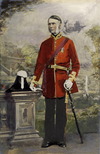LOTTRIDGE (Loteridge), JOHN, Indian agent; brother of Thomas Lottridge of Albany, New York; possibly a son of Richard Lottridge of that town; d. 1763 in the Lake Champlain area.
John Lottridge is first mentioned as a second lieutenant in Edmond Mathews’ company of the New York militia. He was present at Lake George (Lac Saint-Sacrement) in September 1755 when French forces under Dieskau halted a British army marching toward Fort Saint-Frédéric (Crown Point, N.Y.). By 1757 Lottridge was in command of a militia company, but early in 1758 he volunteered to join the Indian service. He was, according to the superintendent of northern Indians, Sir William Johnson*, “a Young Man who had shown Resolution, was a good Woods-man, known to & liked by many of the Indians.”
As an Indian agent with the rank of lieutenant he took part in Lieutenant-Colonel John Bradstreet*’s expedition which captured and destroyed Fort Frontenac (Kingston, Ont.) in August 1758; he was subsequently recommended by Bradstreet and Johnson for a captaincy, a promotion confirmed in October. Until the spring of 1759 he accompanied Indian scouting expeditions on the northern frontier of New York. He was apparently present at the siege of Fort Niagara (near Youngstown, N.Y.) in July 1759. After its capitulation he returned to Oswego (Chouaguen), where he was in charge of Indian affairs during the winter and spring of 1759–60. While there he had a disagreement with Colonel Frederick Haldimand*, the commandant, over the problem of Iroquois who came from Oswegatchie (La Présentation, now Ogdensburg, N.Y.) to trade. Haldimand, thinking them spies, wanted to send them away. Lottridge intervened because he accepted their claim to be on the British side and believed that dismissing them would offend the Six Nations. The dispute illustrates the delicacy of relations with the Indians during the war; it also suggests the impatience with which many British military authorities were inclined to regard the Indian service. They seemed to believe that undue attention was paid to the Indians’ feelings and rather disliked the independence that the Indian agents, who were responsible to Johnson, enjoyed.
By 1760 many Iroquois had allied themselves with the English, and a number of them accompanied Major-General Jeffery Amherst* in the late summer as he headed down the St Lawrence to attack Montreal. Lottridge was with the expedition, scouting in advance of the main force with parties of Indians. After the capitulation of Montreal in September, Lottridge was based there as a subordinate to Daniel Claus*, Johnson’s deputy. Lottridge spent that winter and the following one with the Indians from the area on their annual hunt in the vicinity of Lake Champlain.
In the summer of 1762 Claus reported that Lottridge was “uneasy abt his Situation in Case I should leave this Country as he wont pretend to take the Care of the Indns upon him alone,” but by the autumn Lottridge had taken on that responsibility temporarily and apparently discharged it capablet, although he was doing well in the Indian service, he was concerned for his future since the authorities believed that with the establishment of peace it was safe to make drastic cuts in that department. He considered entering the regular army but was pleased when he was retained in the Indian service, the field he preferred.
Late in 1762 Lottridge travelled into the pays d’en haut and spent the winter “in the trading way” with the “Indians at Millacky,” that is, in southeastern Wisconsin. Either by actually visiting the Sioux or by contact with their neighbours, he gained an impression of the great strength of that nation, about whom the English knew little; and he acquired some buffalo robes and Sioux artifacts to send to Johnson. By the summer of 1763 Lottridge was back in Montreal. On 9 August he attended a conference between General Thomas Gage*, the military administrator there, and the Ottawas of L’Arbre Croche (Cross Village, Mich.), who had escorted James Gorrell and the surviving soldiers from the Michilimackinac region to the safety of Montreal after violence inspired by Pontiac broke out in the pays d’en haut.
Lottridge set out again for the Lake Champlain region in the autumn of 1763. In October word reached Montreal “that Captain Lutteridge is lost in the Bay de Mischisque [Missisquoi], going to explore that Country.”
BM, Add. mss, 21661, ff.36, 107; 21670, f.14. PAC, MG 19, F1, 1, pp.16, 20, 58, 74, 89; 14, p.37. Johnson papers (Sullivan et al.).
© 1974–2024 University of Toronto/Université Laval
Cite This Article
Jane E. Graham, “LOTTRIDGE, JOHN,” in Dictionary of Canadian Biography, vol. 3, University of Toronto/Université Laval, 2003–, accessed April 20, 2024, http://www.biographi.ca/en/bio/lottridge_john_3E.html.
The citation above shows the format for footnotes and endnotes according to the Chicago manual of style (16th edition). Information to be used in other citation formats:
| Permalink: | http://www.biographi.ca/en/bio/lottridge_john_3E.html |
| Author of Article: | Jane E. Graham |
| Title of Article: | LOTTRIDGE, JOHN |
| Publication Name: | Dictionary of Canadian Biography, vol. 3 |
| Publisher: | University of Toronto/Université Laval |
| Year of publication: | 1974 |
| Year of revision: | 1974 |
| Access Date: | April 20, 2024 |











